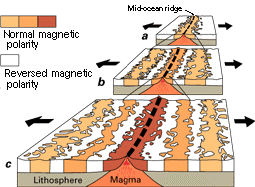Video from Episode 2 "The Deep" of the BBC documentary Earth Story showing ocean floor spreading out from an ocean ridge. As it spreads, it records the polarity of Earth's magnetic field as positive and negative anomalies. In effect, it acts like a giant magnetic tape recorder.
The banding of the magnetic anomalies on the ocean floor can now be explained, if we accept that new ocean crust is being created at the ridges.[1]
Ocean crust is formed primarily of volcanic basalt. The basalt wells up at the mid-ocean ridges and gets pushed out on either side, where it cools to form new crust. As it cools it is magnetised according to the current direction of the Earth's magnetic field.
The closer to the ridge you are, the younger the crust is. Ocean floor created recently, during the period when the magnetic field was the same direction as it is today, is magnetised so that it re-enforces the measured magnetic field, creating a positive anomaly. Slightly older crust, created during a period of reversed polarity, is magnetised in the opposite direction so that it creates a negative magnetic anomaly.
As the magnetic field has flipped between normal and reversed polarity over millions of years, it has been recorded in the newly-created crust as positive and negative anomalies. In effect, the ocean floor has behaved like a giant tape recorder.[2]
The pattern of stripes matches exactly the field reversals found in basalt on land. The land basalt has been dated, which allows us to infer the age of the oceans: the seafloor is all younger than 200 million years old. This is around ten times younger than the average age of the continents.[3]
The theory of ocean floor spreading thus explains the zebra stripes of magnetic anomalies. As a bonus it also explains the texture of the ocean basins: the ocean floor is rough near the ocean ridges because it is young and there hasn't been enough time for sediment to accumulate. Further away from the ridge, sediment has smoothed out the ocean floor over time so that the jagged basalt is no longer visible.
Together these arguments finally clinched the deal in favour of seafloor spreading and hence plate tectonics. But there is one further puzzle: where does the seafloor go at the end of its life?

Snapshots of the ocean floor anomalies at different times with different magnetic polarities.
The seafloor spreading hypothesis was first formulated by Harry Hess in the early 1960s. He based part of his argument on the discovery of flat-topped submarine volcanoes, which he names guyots. These had been eroded at the surface and then sank as the ocean floor bore then away from the ocean ridges. Thus the ocean floor behaves like a conveyor belt originating at the ocean ridges.
The idea of seafloor spreading from the ridges was also put forward by Robert Dietz in a paper in 1961.
The discovery of the origin of the zebra anomaly stripes was made independently by two British scientists, Frederick Vine and Drummond Mathews, and a Canadian geologist Lawrence Morley. It is thus known as the Vine-Matthews-Morley hypothesis.
In effect they converted Hess's conveyor belts to tape recorders.
The geology community was initially very skeptical, but their work made a crucial prediction that they weren't able to check at the time: that the stripes should be symemtric on either side of ridge. This was confirmed in later work.
The Atlantic ridge moves apart at 2.5cm per year.
Around 3.5 square kilometres of ocean crust are added each year.
Hess, H.H. "Evolution of ocean basins", Report to Office of Naval Research on ONR Contract No 1858 (10) (1960).
Hess, H.H. "History of ocean basins", In Petrologic Studies: A Volume to Honor A.F. Buddington (A.E.J. Engel, H. James and B.F. Leonard, Eds.), pp.599-620. Geological Society ofAmerica, Boulder, CO (1962).
Vine, F. J.; Matthews, D H "Magnetic anomalies over oceanic ridges", Nature 199 (4897): 947-949 (1963). Bibcode 1963Natur.199..947V. doi:10.1038/199947a0.
Author: Tom Brown
Copyright: public domain
Date last modified: 7th Oct 2011
Peer-review status: Not yet peer-reviewed
Earth Story
http://commons.wikimedia.org/wiki/File:Oceanic.Stripe.Magnetic.Anomalies.Scheme.gif: public domain